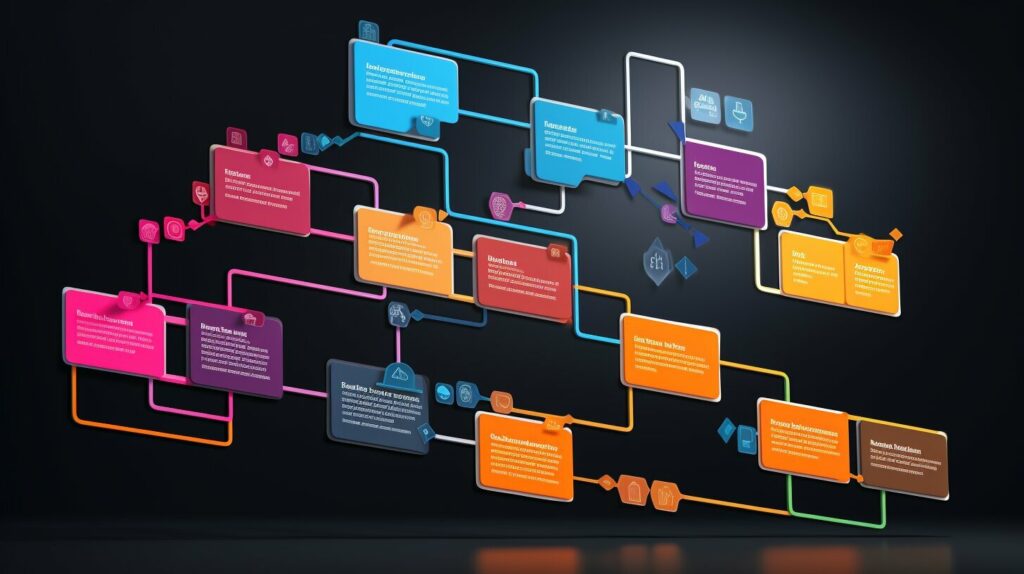Are you tired of feeling like your business is constantly spinning its wheels? Are you looking for a way to streamline your operations and increase productivity? Look no further than a business process review. This ultimate guide to business process review will provide you with everything you need to know about implementing effective business process reviews.
From understanding its significance to exploring practical implementation techniques, you’ll be on your way to enhancing your operational effectiveness in no time.
So buckle up and get ready to take your business to the next level.
Table of Contents
ToggleKey Takeaways
- Business process review is a critical component of operational effectiveness
- Through process improvement and optimization, businesses can enhance efficiency and productivity
- Effective implementation of business process review requires techniques such as process mapping and documentation
- Continuous process improvement is key to long-term success
- Operational effectiveness can be enhanced through the implementation of best practices and effective process review techniques
1. Understanding Business Process Review
Welcome back, fellow process enthusiasts!
In this section, we’ll explore the magical world of business process review. Firstly, let’s clarify some of the terminology. When we use the phrase “process improvement,” we’re referring to the art of making a process more efficient, effective, and performant. Similarly, “process optimization” has everything to do with streamlining a process to make it the best it can be.
But why is business process review so important, you ask? Well, in a world where competition is fierce, increasing business efficiency is critical to staying ahead of the game. To do that, we need to analyze our current processes and identify areas that can be improved.
This is where process analysis comes in. Using a variety of techniques such as value stream mapping, flowcharting, and process mapping, we can map out a process, identify potential bottlenecks, and make recommendations for improvement.
But don’t worry, we won’t leave you hanging without discussing how to evaluate the effectiveness of these improvements. Enter, process evaluation.
a. Process Evaluation Techniques
There are a plethora of process evaluation techniques out there, and it’s important to choose the right one(s) for your specific process. Some of the most popular methods include:
- Process cycle time analysis
- Root cause analysis
- Process benchmarking
Using these techniques, we can determine if the process improvement efforts have been successful and if any further changes need to be made.
But wait, there’s more! In addition to analyzing and evaluating processes, we also need to document them. Process documentation is critical for ensuring that everyone involved in the process understands their role and that the process is consistently executed. Some best practices for process documentation include:
- Using clear and concise language
- Creating diagrams to illustrate the process steps
- Reviewing and updating the documentation regularly
And there you have it. The key aspects of business process review. But before we move on, let’s take a moment to appreciate the beauty of this process map:
| Process Step | Description | Duration |
|---|---|---|
| Step 1 | Receive customer order | 1 day |
| Step 2 | Process customer order | 3 days |
| Step 3 | Ship product | 2 days |
Isn’t it a thing of beauty? Now, let’s move on to the practical implementation of business process review in the next section.

2. Implementing Business Process Review
Now that you have a solid understanding of business process review, it’s time to put it into action. Implementing effective business process review techniques can help streamline your operations and boost your bottom line.
One of the most crucial steps to implementing a business process review is process mapping. This involves breaking down each step of a process and creating a visual diagram to help identify inefficiencies and areas for improvement. By using process mapping, you can gain a clearer understanding of how processes work and where issues may arise.
| Process Mapping Steps | Description |
|---|---|
| Identify the process to be mapped | Determine which process you want to map and why. |
| Select the appropriate mapping method | Choose the type of process map you want to create (e.g. swimlane diagram, value stream map). |
| Collect data and gather insights | Collect data on the current process and identify areas for improvement. |
| Create the process map | Use the data collected to create a visual representation of the process. |
| Analyse and refine the process map | Identify any areas of inefficiency in the process and refine the map accordingly. |
Process documentation is another essential aspect of business process review. By documenting each step of a process, you can ensure that everyone involved understands how it works and can follow it consistently. This can help prevent errors and reduce the risk of miscommunication.
Business process management also plays a critical role in effective business process review. By implementing a comprehensive BPM system, you can automate processes, monitor performance, and identify areas for improvement more efficiently.
Lastly, regularly evaluating and analysing your business processes is crucial for continuous improvement. By reviewing your processes on a regular basis, you can identify inefficiencies and areas for improvement to maximise your operational effectiveness.

a. Streamlining Processes
Streamlining your processes can help you operate more efficiently and save both time and money. By eliminating unnecessary steps and automating processes where possible, you can optimise workflow and boost productivity.
- Eliminate redundant steps
- Automate manual processes
- Optimise workflow
- Identify inefficiencies
- Implement best practices
By following these steps and implementing effective business process review techniques, you can enhance your operational effectiveness and achieve long-term success.
SEE ALSO
- 5 Business Process Review Best Practices You Should Follow
- 3 Benefits of Business Process Review That You Need to Know
- Share Business Process Guide: How To Engage Stakeholders
3. Continuous Process Improvement: The Key to Success
What separates successful businesses from the rest? Apart from innovative products and services, it’s their commitment to continuous process improvement. In today’s ever-changing business landscape, where new technologies and techniques are constantly emerging, companies that prioritize and invest in process improvement are the ones that stay ahead of the curve.
So, how can you achieve continuous process improvement? It starts with identifying areas for improvement, followed by a systematic approach to addressing these issues and streamlining processes. Implementing process improvement strategies such as Lean, Six Sigma, and Kaizen can help optimize your business operations and reduce waste, improving efficiency and output.
a. The Power of Process Mapping
Process mapping is a powerful tool for identifying and visualizing process inefficiencies, irregularities, and bottlenecks. By creating a visual representation of your business processes, you can see how they flow, where they’re prone to errors, and where there may be opportunities for improvement.
With this information, you can develop and implement targeted process improvement strategies that address specific issues and deliver maximum impact.
| Benefits of Process Mapping | Examples |
|---|---|
| Identify areas for improvement | Flowcharts, Swimlane diagrams |
| Improve process efficiency | Value Stream Maps, SIPOC diagrams |
| Reduce errors and rework | Pareto Charts, Cause and Effect diagrams |
Aside from improving process efficiency, process mapping can also enhance collaboration and communication within your team, as it provides everyone with a clear understanding of how their work fits into the bigger picture.
b. The Importance of Process Documentation
Process documentation is another crucial aspect of continuous process improvement. By documenting your business processes, you can create a knowledge base that can be used to train new employees, establish standard operating procedures, and monitor process performance over time.
Process documentation can take many forms, including flowcharts, diagrams, checklists, and narratives, depending on the needs of your organization.
When creating process documentation, it’s important to adopt a systematic and standardized approach. This ensures that your documentation is consistent, easy to understand, and comprehensive. It’s also essential to keep your documentation up-to-date, as processes and procedures can change over time.
c. Continuous Process Improvement: A Mindset, Not a Destination
Continuous process improvement is not a one-time project, but rather a mindset and culture that should permeate throughout your organization. It requires a commitment to ongoing learning, innovation, and collaboration, as well as a willingness to embrace change and take calculated risks.
By adopting a continuous improvement mindset, you can create a more agile and adaptable business that can respond quickly to changes in the marketplace. This can give you a significant competitive advantage and help you achieve long-term success.

Remember, continuous process improvement is not an overnight success story, but rather a journey that requires dedication and perseverance. By embracing a culture of continuous improvement, you can create a more efficient, effective, and profitable business that delivers maximum value to your customers and stakeholders.
4. Enhancing Operational Effectiveness Through Business Process Review
Congratulations! You’ve made it to the end of the Ultimate Guide to Business Process Review. Give yourself a pat on the back and grab a drink (or two) because you deserve it!
But before you do, let’s summarise the key takeaways from this guide and the importance of enhancing operational effectiveness through business process review.
a. The Significance of Operational Efficiency
Operational efficiency is the foundation of a successful business. From streamlined processes to effective communication, a business that runs efficiently can meet customer demand, reduce costs, and increase profitability. By conducting regular business process reviews, you can identify areas of improvement and implement changes that enhance operational efficiency.
b. The Role of Business Strategy
Business process review is not just about improving processes; it’s also about aligning those processes with your business strategy. By examining and analysing your business processes, you can ensure that they are in line with your goals and objectives. You can then make informed decisions about what changes are necessary to achieve your business objectives.
c. The Importance of Continuous Improvement
Process improvement is not a one-and-done task. To achieve long-term success, you must continuously review, analyse and improve your business processes. By implementing best practices and effective process review techniques, you can achieve continuous improvement and keep your business ahead of the competition.
So, there you have it – The Ultimate Guide to Business Process Review! By understanding the significance of business process reviews, you can optimise your processes, enhance your business efficiency, and achieve continuous improvement.
Remember, don’t be afraid to ask for help or use outside resources if needed. With persistence and dedication, you can take your business to the next level!
Frequently Asked Questions – FAQs
What is a business process review?
Business process review is the evaluation and analysis of an organization’s existing processes in order to identify areas for improvement and enhancement.
Why is business process review important for businesses?
Business process review is important for businesses as it allows them to identify inefficiencies, streamline operations, and ultimately enhance their overall performance and competitiveness.
How can business process reviews be implemented effectively?
Business process review can be implemented effectively by utilizing techniques such as process mapping and documentation, employing business process management strategies, and conducting thorough analysis and evaluation of processes.
What is the key to achieving long-term success in business process review?
The key to achieving long-term success in business process review is through continuous process improvement. This involves implementing various process improvement strategies, utilizing effective process mapping techniques, and following best practices for process documentation.
How can a business process review enhance operational effectiveness?
Business process review enhances operational effectiveness by improving efficiency, aligning with business strategy, and continuously seeking opportunities for improvement through the implementation of best practices and effective process review techniques.






